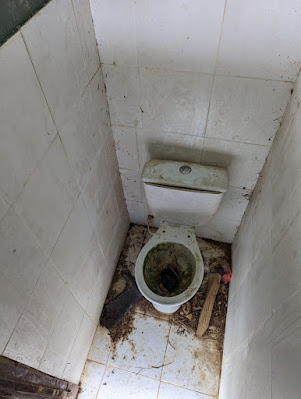Sometimes the journey is more fun than arriving at the destination! We spend a lot of time on the river. Going upstream can take up to twice as long as going downstream. If we are in a large boat with a small motor, the trip can be over four hours. Here are some random pictures of this year's trips.
Our first picture is from a return trip to the village after doing school shopping for the scholarship program. The day was beautiful, with scattered rain showers. We were lucky to have a spectacular rainbow in the background when we stopped for a break about halfway to La Libertad.
Here we are traveling during the rainy season to bring supplies to the village. The pails in the bow of the boat contain food, hardware, paint, and the like. Anything we don't want to be soaked by the rain we put into huge trash bags. This shot was taken during a gentle rain. Slightly before this was a torrential downpour. The visibility was reduced to about 500 feet, so we had to greatly reduce our speed. At times the rain is so heavy that we must pull to the side of the river and wait until it is safe to continue.
During the rainy season, the water level may increase up to 30 feet from the low of the dry season. This lets us go further in the tributaries, up to a mile into the jungle. Cargo is much easier to transport, allowing us to drop off our supplies close to our back door!
The trip upriver can take between four and five hours with our 35-foot wooden boat and a full load. It's a good time to relax (unless you are driving), talk, listen to music, or play around. However, everyone down to the littlest child knows not to rock the boat!
We always try to leave Leticia, the closest city downriver from La Libertad, no later than 2 pm. We account for weather or mechanical problems, which can increase the travel time greatly. At the back of the boat, with the paddle, is Romario, our pilot for the day. It is common to see children as young as 10 years old operating their family's boat.
After we had some problems and needed to change the propellor on our motor, we arrived home to witness a beautiful sunset. Luckily, we always travel with a good flashlight to be visible to other boats, to see logs in the water, and to navigate the narrow waterways in the back part of the village.
At last, we arrived at the village port. Notified by the sound of our motor, and on the alert to our late return, the village children and youth rushed down to greet our boat. They were eager to help carry our supplies up the banks to our houses.




















































